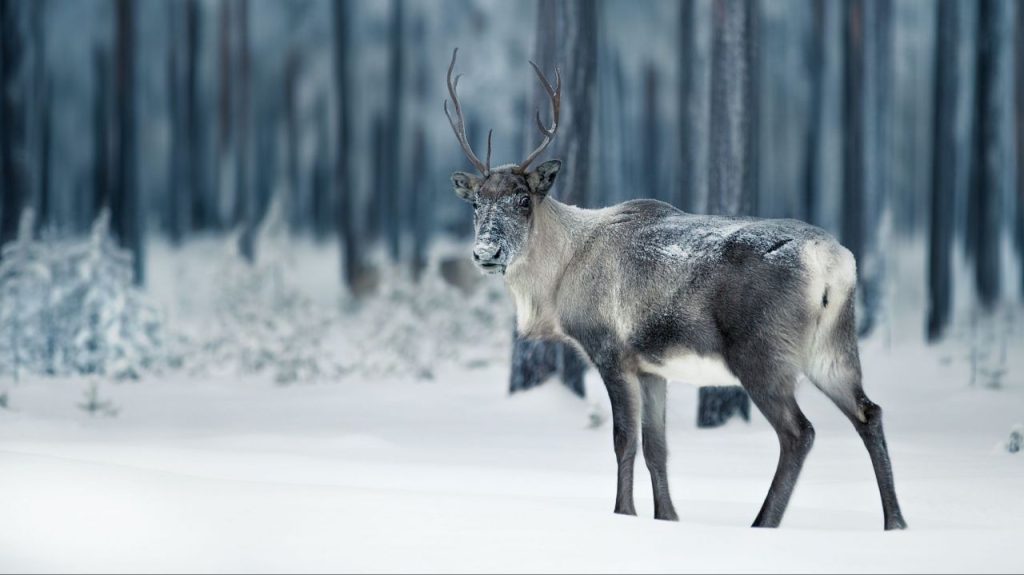Reindeer (Rangifer tarandus): deer in the genus Rangifer.
Kingdom: | Animalia
Phylum: | Chordata
Class: | Mammalia
Order: | Artiodactyla
Family: | Cervidae
Genus: | Rangifer
Species: | tarandus
Reindeer and caribou are the same species (Rangifer tarandus). In North America, they are called caribou if they are wild and reindeer if they are domesticated. In Europe, they are called reindeer.
Size and Weight:
Reindeer are 28 to 53 inches tall at shoulder height. Females weigh 121 to 308 pounds and males weigh 140 to 550 pounds, depending on the time of the year.
Appearance:
Antlers are arguably the reindeer’s most defining characteristic. Compared to body size, reindeer have the largest and heaviest antlers of all living deer species. A male’s antlers can measure up to 51 inches long, and a female’s antlers can reach 20 inches. Reindeer use their antlers as weapons against predators. Males use their antlers to woo the females, and females use theirs to clear away the snow to find food.
Each year, their antlers fall off and grow back larger the following year. Males begin to grow antlers in February and females in May. While both males and females finish growing their antlers at the same time, they shed their antlers at different times of the year. A male drops his in November, while female reindeer keep their antlers through the winter until their calves are born in May.
Reindeer are well adapted to their freezing habitats. Their coat comes in a variety of colors, ranging from dark brown in woodland subspecies to nearly white in Greenland. Their coat is usually a bit darker in summer and lighter in winter. Reindeer have two coat layers, consisting of an undercoat of fine, soft wool that stays right next to their skin, and a top layer of long, hollow guard hairs. The air trapped inside the guard hairs holds in body heat to keep a reindeer warm against wind and cold.
Diet:
Reindeer are ruminants, which are hoofed herbivorous grazing or browsing mammals. They eat mosses, herbs, ferns and grasses when available. They also eat the shoots and leaves of shrubs and trees. In winter, they mainly consume lichen and fungi, scraping the snow away with their hooves to get it. An average adult reindeer eats 9 to 18 pounds of vegetation a day.
Habitat:
Their habitat includes tundra and boreal forest.
Geography:
Reindeer can be found in Scandinavia, Russia, Iceland, Greenland, Alaska and Canada.
Reindeers in natural environment, Tromso region, Northern Norway
Breeding:
A male’s body changes in preparation for the rut, or the “mating season,” which typically occurs in the fall. They rub the velvet off their antlers, their neck swells, their stomach draws in, and they grow a mane of hair under their neck. The males battle each other, with battles even resulting in death. The winner chooses 5 to 15 females to be in his harem. Females that become pregnant leave the herd in the spring and travel to a traditional calving ground. After a gestation period of 7.5 months, they give birth to typically one calf, usually in May and June.
At birth, the newborn weighs 5 to 20 pounds and is able to stand within just one hour after birth. It is not spotted like in other deer species. A reindeer calf drinks its mother’s rich milk and begins adding solid food to its diet at just one week old. By two weeks, it has doubled its birth weight. It is weaned about six months later. Females reach sexual maturity at four years old and males reach sexual maturity at six years old.
Social Structure:
Reindeer are social animals that live in herds of 10 to a few hundred. They may form super herds of 50,000 to 500,000 in the spring. They migrate south to follow food sources, traveling up to 1,000 miles. They communicate with each other through snorts, grunts, and hoarse calls, especially during the breeding season or rut.
Lifespan:
On average, reindeer live 15 to 18 years.
Threats:
Population density, predation, and disease seem to determine reindeer herd sizes. While anti-poaching laws exist to protect reindeer, historically overhunting has caused some reindeer populations to decline. Climate change is also impacting reindeer habitat. As temperatures rise, white-tailed deer move into areas occupied by reindeer. These deer often possess a worm parasite that is fatal to moose and reindeer populations.
Human activity, such as oil exploration and industrial development, has increased and spread into their habitat. While reindeer have been able to adapt to the presence of people and machines, these increasing human activities may pose a threat to reindeer populations.
Conservation Status:
As of 2015, the IUCN has classified the reindeer as Vulnerable on its Red List of Threatened Species.
Source: San Diego Zoo Wildlife Alliance and the IUCN.
The post Reindeer Fact Sheet appeared first on Nature.

